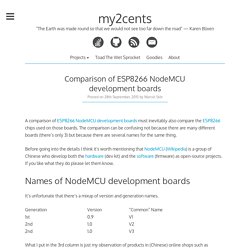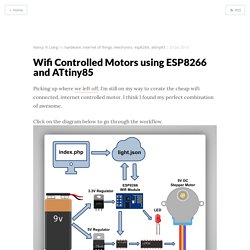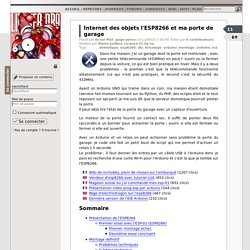

Esp8266/Arduino.
UDP-OSC. The UDP protocol The UDP- and OSC protocols allow the use of normal ethernet network connection to send information between computers and other interactive media systems.

Because of its speed and availability in almost every new computer it's a good replacement for the MIDI interface in many cases. The UDP protocol is based on IP network connections. That means, you address other network clients with an IP address. Unlike the TCP protocol, UDP does not include a procedure for ensuring that individual messages are not lost in transit. UDP should only be used for sending frequent messages that are meant to update information, such as the position information from the motion tracker or data from dynamic fields etc. You have to come up with your own definitions of how the data is structured. The OSC protocol OSC is the abbreviation of OpenSound Control. OSC has been developed by the 'Center for New Music and Audio Technologies' of the university of Berkeley. ESP8266 Send / Receive Binary Data using UDP. Introduction This is a quick introduction into using the ESP8266, more specifically the NodeMCU Dev Board, to send data in binary format over an existing WiFi network.

Comparison of ESP8266 NodeMCU development boards. A comparison of ESP8266 NodeMCU development boards must inevitably also compare the ESP8266 chips used on those boards.

The comparison can be confusing not because there are many different boards (there’s only 3) but because there are several names for the same thing. Before going into the details I think it’s worth mentioning that NodeMCU (Wikipedia) is a group of Chinese who develop both the hardware (dev kit) and the software (firmware) as open-source projects. If you like what they do please let them know. Names of NodeMCU development boards It’s unfortunate that there’s a mixup of version and generation names. What I put in the 3rd column is just my observation of products in (Chinese) online shops such as Banggood and AliExpress. What further contributes to the naming jungle is precisely the fact that the hardware is open-source and anyone can produce and market NoduMCU development boards. Running a Stepper Motor from an Adafruit HUZZAH ESP8266. The ESP-8266 module ported to Arduino - An Introduction. ESP8266 Arduino IDE HowTo.
SquixTechBlog: ESP8266 module comparison: ESP-01, ESP-05, ESP-12, ESP-201, Test Board and NodeMCU. In this post I will guide you through the jungle of available modules based on the ESP8266.

This is not a complete list of available modules but a selection of the ones I could test and review. If you think that I have been missing out on one important module please let me know. Every module here as some advantages and disadvantages, depending on the targeted application. If you are planning to to use a module as Wifi shield for an Arduino you might pick a different type than if you´re planning a standalone node.
Other aspects are breadboard compatibility, availability of pins, need for external components such as a serial-to-usb adapter as well as size and costs. Dislaimer: this post contains affiliate links. This is probably one of the most popular modules, although it is by far not the most convenient one. Arduino ESP8266 espressif iot. [Réalisation] Une ouverture de portail connectée à internet avec un ESP8266 (Wifi) Bonjour à tous, Aujourd’hui je vous propose un projet que j’ai réalisé en à peine quelques heures sur une plateforme qui m’était inconnue !
![[Réalisation] Une ouverture de portail connectée à internet avec un ESP8266 (Wifi)](http://cdn.pearltrees.com/s/pic/th/realisation-microcontroleurs-116904341)
Bon pas totalement vous allez le voir car intégrée à l’IDE Arduino Contexte et problématique Le point de départ de tout ça c’est mon meilleur ami, enfin son portail d’entrée de sa copropriété pour être précis. How to Make Two ESP8266 Talk with each other. ESP8266 as Arduino. How to Make Two ESP8266 Talk with each other. Start [ESP8266 Support WIKI] Register to edit the Wiki Follow on Twitter for the latest NEWS.
![start [ESP8266 Support WIKI]](http://cdn.pearltrees.com/s/pic/th/start-esp8266-support-wiki-116902079)
Also on Facebook The game plan for this page is to make it a Table Of Contents for the rest of the WIKI, then links off the TOC will take you to the real information. Try to not bury info either, one level deep off the TOC for most things and 2 levels for the things that really need it. USE imaginative URLs and page names for better Google Indexing! People can start making a skeleton TOC and then others can fill in the missing pages that link off of the TOC. $3 Wifi module part 6: Unlimited I/O pins?!
$3 Wifi module part 1: FTDI Test. 5$ Arduino WiFi Module!? ESP8266 mini Tutorial/Review. Everything ESP8266 - OSC: UDP <-> SLIP gateway. - Sat Aug 15, 2015 1:41 am#26040 Hello ESP8266 community.

I recently had need to forward OSC messages from TouchOSC to an Arduino (Teensy 3.1) based project. The ideal solution was of course to have esp8266 acting as a gateway to one of the available UARTs. I found the CNMAT OSC library but this didn't work correctly out of the box. After looking through this forum I found ameisso's port of the library with which I was able to successfully receive and respond to messages from TouchOSC.For some reason it does not include the SLIPEncodedSerial part of the CNMAT library. If you simply take SLIPEncodedSerial.cpp and SLIPEncodedSerial.h from CNMAT and put it into the ameisso library folder, serial OSC messages work as well. After some initial issues with losing bytes while reading SLIP messages I was able to get the thing working. Some issues I am aware of: #include <ESP8266WiFi.h>#include <WiFiUDP.h>#include <OSCMessage.h>#include <SLIPEncodedSerial.h> Esp8266 opensound control. Wifi Controlled Motors using ESP8266 and ATtiny85.
Picking up where we left off, I'm still on my way to create the cheap wifi connected, internet controlled motor.

I think I found my perfect combination of awesome. Click on the diagram below to go through the workflow. It will open up a new page. Once you are on the new page, click on the RIGHT SIDE of the screen to go forward, and click on the LEFT SIDE of the screen to go back. Click on the diagram below to go through the workflow. PLEASE NOTE: The ESP8266, index.php, and light.json part was covered the previous tutorial, which goes over how to program an ESP8266 with Arduino IDE, and hook it up to the internet. And as always, you can find the code, diagrams, and all sorts of goodies on this project's GitHub Page. Gather Ye, Ingredients Main Components: Everything ESP8266 - Stepper driver. ESP8266 /DRV8825 alt/azimutal test stepper. Esp8266, internet camera position control, test #2. Internet des objets l'ESP8266 et ma porte de garage. Dans ma maison, j'ai un garage dont la porte est motorisée ; avec une petite télécommande (433MHz) on peut l' ouvrir ou la fermer depuis la voiture, ce qui est bien pratique en hiver.

Mais il y a deux problèmes : le premier c'est que la télécommande fonctionne aléatoirement (ce qui n'est pas pratique), le second c'est la sécurité du 433MHz. Ayant un Arduino UNO qui traîne dans un coin, ma maison étant domotisée (serveur fait-maison tournant sur du Python, du PHP, des scripts shell et le tout reposant sur xpl-perl) je me suis dit que le serveur domotique pourrait piloter la porte. Il peut déjà lire l'état de la porte du garage avec un capteur d'ouverture. Le moteur de la porte fournit un contact sec. Il suffit de ponter deux fils raccordés à un bornier pour actionner la porte : ouvrir si elle est fermée ou fermer si elle est ouverte.